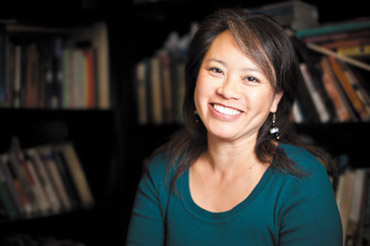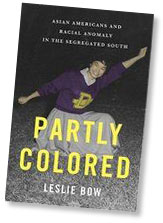Q&A: Professor examines those ‘outside the color lines’ in new book
The history of segregation in the United States is often seen in black and white. Leslie Bow, professor of English and Asian American studies, is interested in the experiences of communities that fell outside those color lines. In her new book, Partly Colored: Asian Americans and Racial Anomaly in the Segregated South, Bow examines what segregation demanded of people who did not fall into the category of black or white — including Asians, American Indians and people of mixed race.

Leslie Bow, professor of English and Asian American studies, explores how the color line accommodated, or refused to accommodate, “other” ethnicities within a binary racial system.
Photo: Bryce Richter
Wisconsin Week: What did segregation mean for people who — as you described it — stood outside the color lines? You posed the question, “Where did the Asian sit on the segregated bus?’
Leslie Bow: I think what’s most interesting to me about a project like this is that we often conflate race with African-Americans or see race as a black-white issue. When we say “multiculturalism” … we don’t think conceptually or theoretically about the challenge that poses to the way we think about racial history in the United States.
WW: In the book, you mention the story of a woman who was in Arkansas, a Japanese-American on furlough from an internment camp and seemingly surprised that she was being waved to sit at the front of the bus as opposed to the back of the bus.
LB: Yet you couldn’t say here’s an example in which Asians were being treated as white people, because then the question would be, “What does ‘whiteness’ mean if you are put in an internment camp?” So one of the parallels to that is a Japanese-American man, Nobu Honda, who gave testimony about what it means to be on furlough from the Army in World War II and traveling around the segregated south. He, too, had that experience of being invited to sit in the white person’s section of the bus at the same time he was serving in a segregated military unit.

In Partly Colored: Asian Americans and Racial Anomaly in the Segregated South, Bow examines what segregation demanded of people who did not fall into the category of black or white.
Photo: Jeff Miller
WW: You mentioned your parents, who are Chinese-American. They attended white schools in Arkansas but didn’t socialize with and weren’t invited to the homes of their white classmates and I wondered how much their experience impacted your research interests?
LB: Definitely, because it was something that they themselves did not talk about. What I found was that they mediated that experience by creating a third level of segregation where there was limited social engagement with either whites or blacks. Their social context was wholly Chinese-American at the time. So, to me that was just the jumping off point for really an exploration of ambiguity, which is very much the bread and butter of literary studies: How you come to this process of interpreting multiple meanings within any given text.
WW: How do your parents reflect on their experiences now… do they see their experiences differently now at all or reflect on them in a different way?
LB: It’s still something that they don’t feel that comfortable about talking about and I think that’s primarily because, like everyone, we see our own experience as something that just happens to us or we see it coming from a series of choices that we ourselves have made… It’s not a comfortable topic in American culture, precisely because we prefer to believe that we make our lives, we make our choices, we don’t have barriers and we don’t have privileges. And so that’s getting to the heart of what’s interesting to me about the work that I do in race studies: how do you begin to uncover those systems that predate us and that we are compelled to live out? Or that we can change.
WW: You also write about portrayals of race in current media and I’m wondering for you, what do you feel you learn from some of those representations that you bring to bear in the writing you do or your teaching?
LB: I’m working on depictions of racial fantasy and I’m really stunned by the fact that in American popular culture, we actually prefer to deal with racial issues in fantasy forms. The most obvious example of that is the movie Avatar where we understand the idea of cultural difference and racial hierarchy through fantastic mediums and through allegory rather than actual populations. So to see movies like Avatar, to see movies like District 9 about South Africa … I’m fascinated about the ways in which the retranslation of civil rights gets displaced into imaginary realms — always present, yet distanced from “real” politics.
Tags: books, College of Letters & Science, faculty




